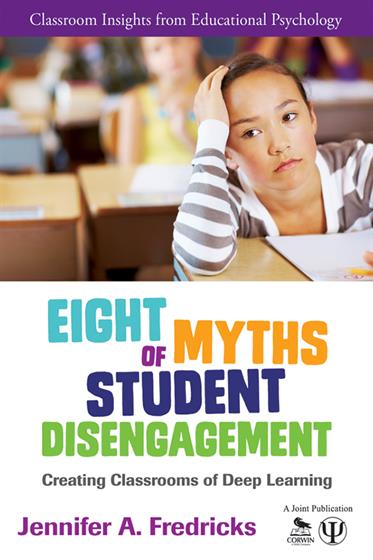Preface
Acknowledgments
About the Author
About the Contributors
Introduction
Myth 1. It's Easy to Tell Who Who Is Engaged: What Is Engagement and How Can I Assess It in My Classroom?
Portraits of Engagement
What Is Engagement?
Why Assess Engagement?
Consistency, Duration, and Variation in Engagement
Methods for Assessing Engagement
Chapter Summary
Text-to-Practice Exercises
Key Terms and Concepts
Research-Based Resources
Myth 2. Some Students Just Don't Care: How Disengagement Is More Than Just a Lack of Student Motivation
School Versus Out-of-School Tasks
Teacher-Student Relations and Disengagement
Peer Relations and Disengagement
Chapter Summary
Text-to-Practice Exercises
Key Terms and Concepts
Research-Based Resources
Myth 3. What Happens Outside of School Competes With Academics: How Out-of-School Time and Families Affect Engagement in School
Extracurricular Activity Participation and Academic Outcomes
Variation in Engagement Across Contexts
Self-Determination Theory and Engagement
Families and Engagement
Barriers to Parent Involvement
Chapter Summary
Text-to-Practice Exercises
Key Terms and Concepts
Research-Based Resources
Myth 4. Hands-On Is Minds-On: How to Create More Engaging Classroom Tasks That Result in Deep Learning
Designing Classroom Tasks for Engagement
Cognitive Components of the Task
Authentic Tasks
Authentic Instructional Models
Motivational and Cognitive Challenges With Authentic Instruction
Strategies for Implementing Cognitively Complex Tasks
Chapter Summary
Text-to-Practice Examples
Key Terms and Concepts
Research-Based Resources
Myth 5. Focus on Content: Don’t Make It Personal: How Relationships Matter for Student Engagement
Teacher Support and Student Engagement and Achievement
Essential Characteristics of Meaningful Teacher-Student Relations
Building Relatedness in the Classroom
Being an Autonomy-Supportive Teacher
Supporting Students' Need for Competence
How Teachers Support Cognitive Engagement
Barriers to Developing High-Quality Relationships
Building Relationships With Difficult Students
Connecting With Diverse Students
Chapter Summary
Text-to-Practice Exercises
Key Terms and Concepts
Research-Based Resources
Myth 6. Socializing With Peers Detracts From Student Engagement: How to Create a Peer Context That Supports Engagement
Why Are Peer Relationships Important?
Friendships
Teachers' Beliefs and Instructional Practices
How Do Peers Socialize Engagement?
Cooperative Learning and Collaborative Instruction
Key Strategies for Supporting Cooperation and Collaboration
Creating Classroom Communities
Chapter Summary
Text-to-Practice Exercises
Key Terms and Concepts
Research-Based Resources
Myth 7. There’s Only So Much a Teacher Can Do: How to Help Those Students Still Struggling to Succeed
Why Is It Important to Resist Disengagement?
Risk Factors for Disengagement
Why Is a Student Disengaged?
Boys and Disengagement
Academic Problems and Disengagement
Students With a History of Behavioral Problems
African American, Hispanic, and Low-Income Students and Disengagement
Interventions to Increase Engagement
Chapter Summary
Text-to-Practice Exercises
Key Terms and Concepts
Research-Based Resources
Myth 8. Student Engagement Is a Student Choice: Choosing to Make the Effort and Not Waiting for Engagement to Happen
References
Index



